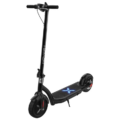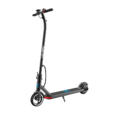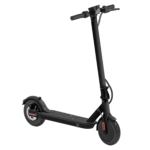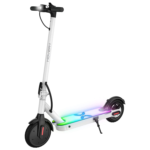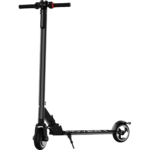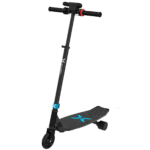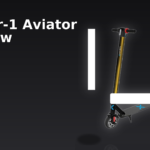- Home
- Scooters
- Electric Scooters
- Hover-1 Comet (Kids)
Hover-1 Comet (Kids)
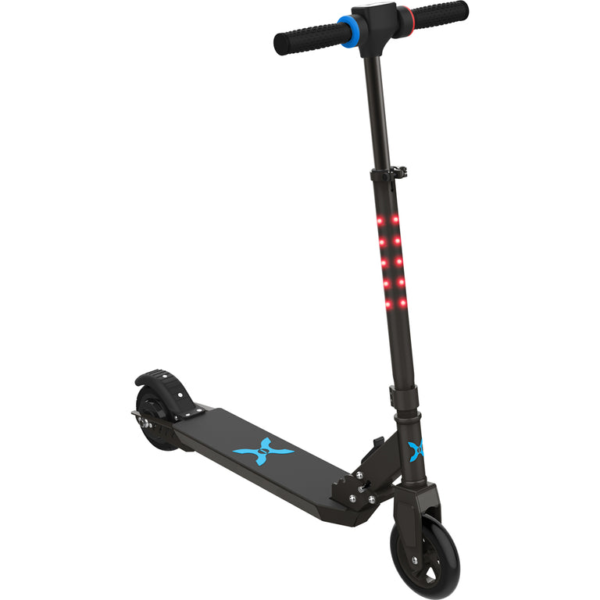

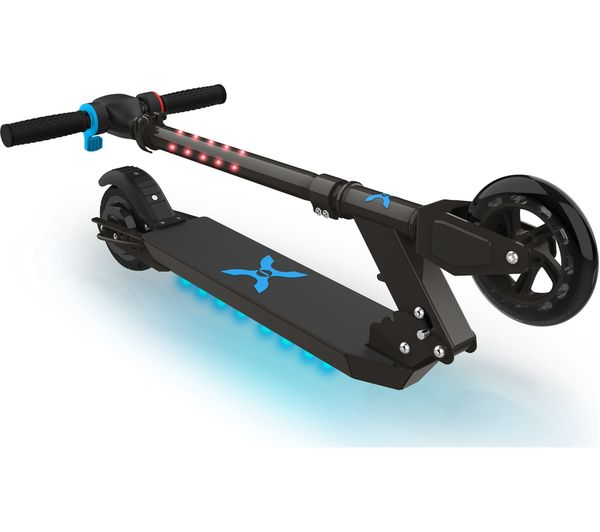
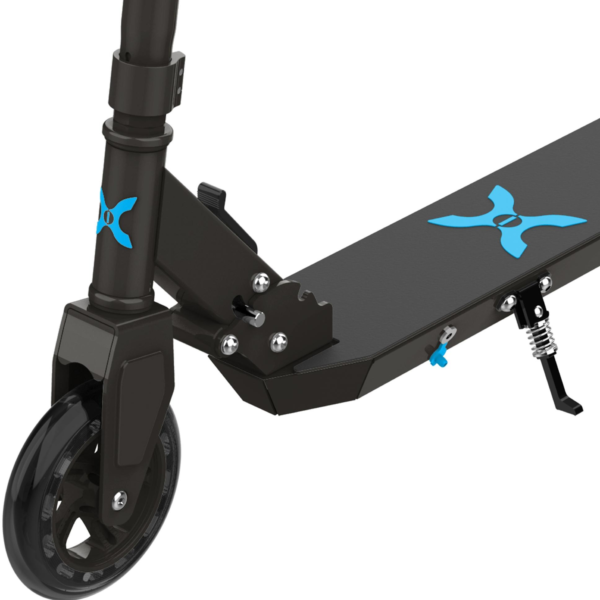
- Battery Range: up to 5 miles (8 km)
- Top Speed: 10 mph (16 km/h)
- Motor Power: 200 W
- Weight Capacity: 132 lb (60 kg)
- Charging Time: ≈4 h
- Scooter Weight: 22.0 lb (10.0 kg)
PROS
- Kid-friendly sizing
- Electronic + foot brake
- Front 6″ / rear 5.5″ solid tires
- LED headlight & brake light
- 90-day warranty support page
CONS
- Short range for longer play
- No suspension
- IP rating not listed

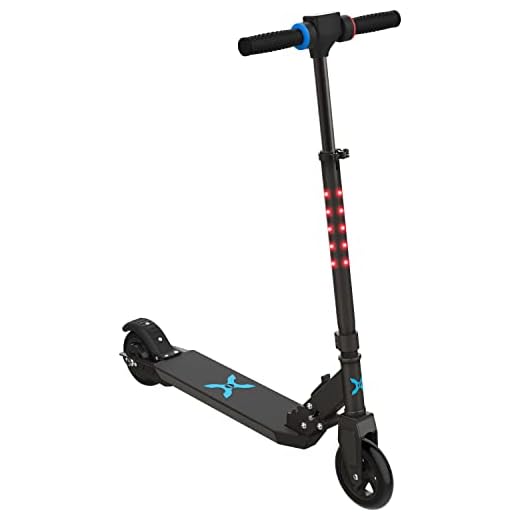
Table of contents
- What Is the Hover-1 Comet?
- How the Hover-1 Comet Works
- Key Specifications (clean table)
- Design & Build Quality
- Performance Fundamentals
- Battery, Range & Efficiency
- Ride Quality & Comfort
- Braking & Safety Features
- Portability & Daily Usability
- Maintenance & Care
- Weather & Seasonal Considerations
- Hover-1 Comet vs Alternatives
- Who the Hover-1 Comet Is (and Isn’t) For
- FAQs
- Glossary
- Final Thoughts
The Hover-1 Comet is a kid-friendly, foldable electric scooter designed for short rides, school runs, and neighborhood fun. It caps speed at a modest 10 mph (16 km/h), carries up to 150 lb (68 kg), and folds quickly for trunk or hallway storage. Because it uses small solid tires, simple brakes, and an easy thumb lever, the Comet favors safety and simplicity over raw speed. As a result, if you want a first electric scooter that teaches good riding habits without overwhelming a young rider, the Hover-1 Comet fits that role well.
What Is the Hover-1 Comet?
In plain terms, the Hover-1 Comet is an entry-level children’s e-scooter built around a small brushless hub motor, a compact lithium-ion battery, and a sturdy folding frame. Moreover, it weighs just 22 lb (10 kg), so most adults can lift it with one hand. The scooter suits riders eight years and up, provided they meet the minimum rider weight and follow local rules. Because the top speed and acceleration are intentionally limited, many parents consider it a sensible stepping stone before a teen moves up to a faster commuter model.
Additionally, the deck sits low to the ground, which helps confidence at low speeds. The solid tires remove puncture worries and reduce maintenance. Meanwhile, the cockpit uses a central LED display that shows speed and battery level at a glance. Two separate brakes—an electronic brake actuated at the bar and a manual foot brake over the rear wheel—give kids a clear, intuitive feel for stopping. Furthermore, bright accent lights on the stem and under the deck increase visibility to others and add a little showmanship at dusk.
Most important, the Hover-1 Comet keeps the riding experience simple. You unfold the stem, press the power button, and push off. Once rolling, a gentle press on the accelerator propels the scooter up to its capped speed. Because the battery is small (25.2 V, 4.0 Ah; about 100.8 Wh), the rated range stays short—up to 5 miles (8 km) under ideal conditions—which is perfect for neighborhood loops and quick school runs. Consequently, the Comet encourages short, supervised rides rather than long, unsupervised trips.
How the Hover-1 Comet Works
At its core, the Comet uses a 200 W brushless rear hub motor. Think of the motor as a compact, sealed wheel that converts battery energy directly into motion. There are no chains or belts to adjust, and there’s little to tune. Therefore, the motor produces smooth, predictable torque that feels gentle off the line. Because power is modest, heavier riders or steeper hills will slow it down, but that’s by design for a kids scooter.
A basic controller manages the flow of current to the motor. When the rider presses the accelerator lever, the controller increases current in small steps. That design reduces sudden surges and helps new riders build confidence. In addition, the controller coordinates the electronic brake. When the rider squeezes the left control (or releases the throttle, depending on the setup), the controller cuts power and applies a gentle electronic braking effect through the motor itself.
The battery sits inside the deck. It’s a 25.2 V, 4.0 Ah lithium-ion pack that stores about 100.8 Wh of energy. Charging is simple: plug the wall charger into the port on the deck, wait about four hours, and watch for the indicator that signals a full charge. Because the pack is small, charging from half takes less time. To protect the battery, avoid deep discharges, extreme heat, and long storage while empty or completely full. In practice, keeping the pack between 30% and 80% for day-to-day use works well.
Controls are intentionally minimal. You get a power button, a speed/battery display, an accelerator, and brake levers (including a rear fender foot brake). Often, double-pressing the power button toggles the light strips on the pole and under the deck. The folding mechanism uses a lever at the front of the deck; pull and lift to unfold, or pull and lower to fold until it clicks. As a result, setup and pack-down take only seconds.
Key Specifications (clean table)
All data below reflect the manufacturer’s published specifications. Imperial and metric units are shown together for clarity.
General
| Item | Value |
|---|---|
| Model | H1-COMT |
| Net Weight | 22 lb (10 kg) |
| Rider Weight Range | 44–150 lb (20–68 kg) |
| Intended Rider Age | ~8+ (always follow local rules and supervision guidance) |
Performance & Power
| Item | Value |
|---|---|
| Motor | 200 W brushless rear hub |
| Top Speed | Up to 10 mph (16 km/h) |
| Hill Riding | Best on gentle slopes; short kicks help on steeper grades |
Battery, Charging & Electrical
| Item | Value |
|---|---|
| Battery Voltage / Capacity | 25.2 V / 4.0 Ah (≈100.8 Wh) |
| Battery Type | Lithium-ion |
| Rated Range | Up to 5 miles (8 km) |
| Charge Time | ~4 hours |
| Charger Input | AC 100–240 V, 50/60 Hz |
| Display | LED digital speed and battery indicators |
| Lighting | Stem and under-deck accent lights (power button double-press toggles) |
Build & Dimensions (include folded dimensions)
| Item | Value |
|---|---|
| Frame | Folding aluminum/steel assembly |
| Unfolded Size | 37.4 in (H) × 33.8 in (W) × 14.96 in (D) — 95 × 86 × 38 cm |
| Folded Size | 10.6 in (H) × 31.4 in (W) × 14.9 in (D) — 27 × 80 × 38 cm |
| Tires | Solid / non-pneumatic; 6 in (front), 5.5 in (rear) |
Safety & Control
| Item | Value |
|---|---|
| Brakes | Electronic brake + mechanical foot brake (rear) |
| Visibility | Stem and deck lights for side awareness |
| Compliance | UL-certified model |
| Water Resistance | No published IP rating; avoid wet riding |
Features & Extras (include Cruise Control if relevant)
| Item | Value |
|---|---|
| Display Mode | Speed and battery readouts |
| Height Adjustment | Multi-position steering column clamp |
| Kickstand | Included |
| Cruise Control | Not included |
Warranty & Compliance
| Item | Value |
|---|---|
| Warranty | 90-day limited parts and labor (manufacturer policy) |
| Certification | UL-certified e-scooter model |
Design & Build Quality
The Hover-1 Comet emphasizes sturdy simplicity. The folding mechanism uses a forward deck lever and a locking click in both directions. Consequently, a parent can fold it in seconds and slide it anywhere a compact push scooter would fit. The stem feels stout for the scooter’s size; you can expect a small amount of flex under a heavier kid, which is normal at this weight and wheel size.
The deck is low and broad enough for small feet in a forward-facing stance. Young riders benefit from the low center of gravity, because it makes balance easier during starts, stops, and slow turns. In addition, the deck and stem include accent lighting, which helps others see the scooter. The plastics around the cockpit and rear fender feel utilitarian. Nevertheless, they’re built to withstand casual bumps, though you should avoid curbs and big potholes.
The cockpit layout is clean. The LED display sits front and center so the rider can check speed and battery level without tilting the head. The accelerator lever is short throw, which helps prevent wrist fatigue over longer rides. Meanwhile, the left-side electronic brake gives a mild, predictable slowdown. For full stops, riders use the rear foot brake, which hugs the tire and adds mechanical force safely.
Solid tires define the Comet’s character. They remove flats and pump checks from the routine and resist small debris. However, because they can’t deform like air-filled tires, they transmit more vibration from rough pavement. Still, at the Comet’s limited speed, that trade-off is acceptable for many families. The wheels are small—6 inches front, 5.5 inches rear—so teach riders to slow down before rolling over cracks and to steer around larger gaps. As a rule, smooth lines and relaxed knees make every surface easier.
Fit-and-finish is what you expect at this level. There’s a visible seam here and there, yet the parts line up and the latch engages with a positive feel. The included kickstand supports the scooter reliably on flat surfaces. The charge port sits on the deck’s side and uses a standard protective cap. Above all, keep that cap seated to prevent dust and moisture from collecting inside.
Performance Fundamentals
From a standstill, the Hover-1 Comet eases into motion rather than jumping forward. That gentle start is ideal for first-time riders. As speed builds, the scooter cruises happily on flat roads. On very smooth surfaces, it tracks straight with minimal input. On older asphalt or brick, the small wheels will ask you to steer actively and keep your knees soft. Consequently, a calm stance pays off in control and comfort.
Acceleration remains modest. A light rider will notice a steady pull up to about 7–8 mph, with the last couple of miles per hour arriving gradually. That taper keeps the scooter calm near its 10 mph (16 km/h) limit. Likewise, the electronic brake starts slowing the scooter as soon as the rider actuates it, but it’s tuned for stability rather than emergency stops. The foot brake adds the bite that brings speed down quickly in the last few feet.
On hills, the experience depends on grade and rider weight. On a typical residential rise of 7–8%, many kids will need a few pushing kicks to help the motor. Short neighborhood inclines are fine with momentum. However, longer climbs will sap speed, which is expected for a 200 W hub motor. Therefore, teach riders to look up the road and carry speed into hills, then help the scooter with a push while keeping both hands on the bar.
Above all, stability at speed is reassuring. At the capped top speed, the Comet remains composed if the rider stands centered and resists stiff-arming the bar. If the surface gets wavy or the rider locks their knees, a mild shimmy can appear. To cure it, soften the knees and elbows, then slow slightly. In time, those habits become automatic.
Battery, Range & Efficiency
The Comet’s battery stores about 100.8 Wh of energy (25.2 V × 4.0 Ah). Under ideal conditions—warm weather, flat roads, a light rider, and smooth pacing—the scooter can travel up to 5 miles (8 km). Real-world results vary, because temperature, wind, hills, and riding style all influence efficiency. Consequently, plan routes with a buffer.
Here’s how conditions typically affect range:
- Rider weight: Heavier riders draw more current to hold speed. Expect shorter rides near the 150 lb (68 kg) limit.
- Temperature: Lithium-ion cells deliver less energy when cold. Below about 40 °F (4 °C), range can drop significantly.
- Terrain: Frequent stops, rough asphalt, and hills reduce effective range.
- Speed habits: Holding near top speed drains faster. Varying speed gently helps.
To get the most from each charge, start with a full battery, avoid rapid stop-and-go, and keep tires and bearings clean. In addition, plan loops that circle home rather than one-way runs. If your child rides until the last bar, give the scooter a few minutes to cool before charging. For storage, park the scooter around half charge and in a dry, cool room. That routine supports battery health over time.
Charging is straightforward. Connect the charger to AC power first, then to the port. A typical full charge takes about four hours. Because the pack is small, adding a quick hour top-off before a ride can bring back a surprising amount of range. Always use the included charger and keep the port cap closed when not in use. Thus, you reduce wear on the connector and keep moisture out.
Ride Quality & Comfort
Small solid wheels trade plushness for durability. On smooth paths, the ride feels quiet and composed. On chip-seal or cracked sidewalks, the scooter passes more vibration to the rider’s feet and hands. Therefore, encourage kids to bend their knees slightly and keep their weight neutral over the deck. That posture turns the body into natural suspension and keeps the bar steady.
The deck height and stance help stability. With feet placed front to back, the rider can absorb bumps with the rear leg while keeping the front leg relaxed. The grips have enough texture to resist slipping without being harsh on small hands. The adjustable steering column allows basic height tuning. Ideally, set it so the rider’s elbows remain slightly bent with shoulders relaxed.
Noise levels stay low. Brushless hubs make a soft whir under power, and the drivetrain has no chains or belts to rattle. At low speed, the loudest sound often comes from the tires rolling over sidewalk joints. That’s normal. If you hear scraping or rubbing, stop and inspect the fender and wheel for lodged debris. Afterward, spin the wheel to confirm free motion before riding again.
Because the scooter is light, crosswinds and rider inputs can nudge it more than a heavier adult model. Consequently, teach riders to look far ahead, keep their upper body calm, and steer with small adjustments. That single habit makes the Comet feel more planted everywhere.
Braking & Safety Features
The Hover-1 Comet uses two braking systems that complement each other:
- Electronic brake: Triggered at the bar, it slows the motor electrically. Think of it as gentle engine braking—smooth, quiet, and ideal for speed trimming.
- Mechanical foot brake: Press the rear fender to apply friction at the wheel. It adds stopping power when you need to come to a full halt.
Together, these brakes produce predictable deceleration with a firm, confidence-building feel. Therefore, practice both in an empty lot. Start with the electronic brake to scrub speed and finish with the foot brake to stop fully before intersections or driveways.
For visibility, the Comet includes stem and under-deck lights. They help others notice the rider from the side, especially at dusk. Because there’s no published headlight spec here, assume lighting supplements rather than replaces the need for bright clothing and a certified helmet. Additionally, reflective elements on clothing or a backpack increase conspicuity from a distance.
Compliance is straightforward: the Comet is a UL-certified e-scooter model. Treat it like any small electric vehicle—inspect before rides, wear protective gear, and follow local rules. If your city restricts sidewalk riding or requires specific equipment, adjust accordingly.
There’s no published IP rating, so treat wet surfaces as off-limits. Water can reduce traction, harm electronics, and increase stopping distance. If the scooter gets splashed, power it down, wipe it dry, and let it sit before the next ride. In short, dry conditions are safer and easier on components.
Portability & Daily Usability
At 22 lb (10 kg), the Hover-1 Comet is genuinely easy to carry. The fold lever makes the process quick: pull, rotate the stem down, and listen for the latch click. The folded size—10.6 × 31.4 × 14.9 in (27 × 80 × 38 cm)—fits in a car trunk, a locker room corner, or an apartment hallway. Because it’s light, you can carry it up stairs with one hand while keeping the other free for a door or rail.
Daily routines are simple. Charge it after school, top up before a weekend ride, and store it indoors. The kickstand helps with quick stops at playground benches or garage floors. If you use a cable lock, thread it through the rear wheel and frame rails without stressing the folding joint. Never lift or secure the scooter by the stem latch alone. Instead, lift at the deck or lower stem where structure is strongest.
A quick pre-ride check goes a long way: flip the scooter upright, test the brakes, glance at the battery bars, and make sure the folding latch is fully seated. Also, ask the rider to wiggle the handlebar gently. If you feel free play, tighten the stem clamp before riding. Finally, confirm the wheels spin freely and the fender is clear of debris.
Maintenance & Care
The Comet asks for little care, yet a simple schedule keeps it feeling new.
Before every ride
- Check folding latch, stem clamp, and handlebar ends.
- Tap the rear fender to confirm the foot brake moves freely.
- Press the electronic brake lever to ensure it actuates.
- Scan the tires for cuts or lodged stones.
Weekly
- Wipe grit from the deck and wheels with a soft, damp cloth.
- Inspect the charge-port cap. Reseat if loose.
- Confirm the kickstand springs back firmly.
Monthly (or every ~50 miles / 80 km)
- Check for loose fasteners at the hinge, wheel axles, and fender. Tighten gently if needed.
- Examine the rear brake contact area for excessive wear.
- Review battery habits: avoid storing at 0% or 100% for long periods.
Seasonally
- Clean dust from the folding joint and apply a tiny amount of dry lubricant to the latch pivot (never near the tire).
- Inspect the charger cable for nicks. Replace if damaged.
- Test a full discharge and recharge under supervision to confirm the battery still reaches a normal full indicator.
Avoid pressure washing. Keep the scooter away from rain, sprinklers, and puddles. If the display dims unexpectedly, charge the scooter and let it rest inside for an hour. Often, minor hiccups resolve with a full charge cycle and a clean, dry environment. Otherwise, contact the manufacturer for guidance.
Weather & Seasonal Considerations
Cold: Below about 40 °F (4 °C), lithium-ion cells deliver less energy and voltage sags increase. Range drops, acceleration softens, and the display may show bars falling quicker than usual. Warm the scooter indoors before the next ride. Never charge a frozen-cold battery; let it reach room temperature first.
Heat: High temperatures accelerate cell aging. Don’t leave the scooter in a parked car on hot days. Charge in a ventilated room and unplug when full. If the deck feels unusually warm after a long ride, give it time to cool before charging. Consequently, the pack undergoes less stress across the season.
Rain and Wet Roads: The Comet lacks a published IP rating and the manual warns against water exposure. Wet surfaces also stretch stopping distances and increase slip risks for solid tires. Choose dry routes. If you encounter a sudden sprinkle, slow down, head home, and wipe the scooter dry. Afterwards, let residual moisture evaporate indoors.
Storage: For off-season storage, charge to roughly half and check the level monthly. Store in a dry, indoor location away from direct sun. That habit preserves both the pack and the plastics. Additionally, avoid stacking heavy items on the folded scooter to prevent latch misalignment.
Hover-1 Comet vs Alternatives
Because the Comet is a kids e-scooter, it shouldn’t be compared directly with adult commuter or performance models. Instead, think of three broad categories and when the Hover-1 Comet shines. And if your rider is starting to outgrow this model and needs a little more headroom, a natural step-up in the same family is the Hover-1 Alpha.
Kids/Youth class (the Comet’s home turf)
- Where it excels: Safety-minded top speed, gentle acceleration, light weight, and simple controls. The small battery shortens charge time and keeps the deck slim. Solid tires remove flat worries.
- Trade-offs: Shorter range and limited hill strength. Smaller wheels demand smoother lines over rougher pavement.
Commuter class (larger wheels, more range)
- Where they excel: Bigger batteries (often 270–500 Wh+), wider decks, and air-filled tires that smooth cracked roads. They handle longer school commutes or mixed urban terrain.
- Trade-offs: Heavier frames (30–45 lb / 14–20 kg), faster speeds that demand more skill, and more maintenance tasks (tire pressure, brake tuning). Consequently, these scooters suit teens or adults with experience.
Performance/off-road class (high power, suspension)
Trade-offs: Very heavy, expensive, and absolutely not appropriate for young riders. They require advanced skills and protective gear. Therefore, keep these out of the conversation for kids.
Where they excel: Steep hills, trail exploration, and high-speed stability thanks to dual motors, suspension, and hydraulic brakes.
Who the Hover-1 Comet Is (and Isn’t) For
Great for
- Kids around eight and up who are ready to graduate from a kick scooter.
- Families who want short, supervised rides around the block or to the park.
- Multi-modal days that involve a car trunk or a walk-up apartment, thanks to easy folding and low weight.
- Parents who value low maintenance and the certainty of solid tires.
Not ideal for
- Long daily commutes or round trips beyond 3–4 miles (5–6.5 km) without a charge stop.
- Steep neighborhoods where grades sit well above 7–10%.
- Wet climates where puddles and rain are frequent.
- Adult riders near or above the 150 lb (68 kg) limit.
When in doubt, start small. A few weeks on the Comet builds scooter sense: scanning ahead, braking early, and cornering smoothly. Those habits transfer to every scooter a young rider uses later. In the long run, that foundation matters more than speed.
FAQs
1) How fast does the Hover-1 Comet go?
Up to 10 mph (16 km/h) on flat ground with a properly charged battery and a light to medium rider.
2) What is the real-world range?
Plan on 2.5–5 miles (4–8 km) depending on rider weight, temperature, hills, and speed habits. As always, short loops near home work best.
3) Can the Hover-1 Comet climb hills?
It handles gentle neighborhood grades. For steeper or longer hills, help with a few pushing kicks while keeping both hands on the bar.
4) Does the Hover-1 Comet have cruise control?
No. The Comet uses a simple accelerator and brake setup without cruise control.
5) What does “UL-certified” mean here?
It indicates the scooter meets a recognized third-party safety certification for electric products. Even so, it’s not a riding permission slip; still follow local rules and supervise young riders.
6) How should I charge and store the battery?
Charge after rides, avoid leaving it empty, and store indoors at moderate temperatures. For long storage, leave it around half charge and check monthly.
7) Where can I find a quick “Hover-1 Comet overview” for new riders?
Show them the display, accelerator, and both brakes in a quiet area. Then, practice starts and stops, and set a simple out-and-back route within range.
Glossary
Amp-hour (Ah): A unit of battery capacity. Multiply Ah by pack voltage to estimate watt-hours.
Watt-hour (Wh): A measure of stored energy. Higher Wh usually means more range.
Brushless hub motor: A motor built into the wheel with permanent magnets; efficient and low-maintenance.
Controller: The electronic brain that meters battery current to the motor and manages functions like the electronic brake.
Electronic (regen) braking: Motor-based braking that slows the wheel electrically; smooth and best for speed trimming.
Foot brake: A fender-style mechanical brake that presses on the rear wheel to add strong stopping force.
Stem flex: The slight bending you feel in the handlebar stem under load; a bit is normal on light scooters.
Solid tire: A non-pneumatic tire that can’t go flat but rides firmer than an air-filled tire.
IP rating: Ingress Protection rating for dust/water resistance. Not published for the Comet; avoid wet riding.
Charge cycle: One full discharge and recharge; battery life depends on many gentle cycles, not hard, deep drains.
Top speed: The maximum speed under ideal conditions; capped here for safety.
Throttle: The lever that commands acceleration; gentle pressure yields smooth speed increases.
UL certification: A third-party safety certification for electrical products.
Kickstand: A small stand that holds the scooter upright when parked.
Folding latch: The mechanism that locks the stem up or down for riding or carrying.
Final Thoughts
The Hover-1 Comet focuses on what matters for a first e-scooter: safe speed, simple controls, quick folding, and minimal upkeep. Its short range and modest power are features, not bugs, when your goal is supervised fun and skill building. With a few smart habits—dry weather, gentle routes, and routine checks—the Comet can deliver countless neighborhood rides and set a young rider up for confident scooting in the years ahead. In summary, it offers a balanced blend of safety, ease, and durability for growing riders.
Specifications
General
| Model The Model specifies the exact version or name of the scooter. It helps identify its unique design, features, and specifications within the manufacturer’s product line. Knowing the model makes it easier to compare options, find compatible accessories, or look up support information. | Comet (Kids) |
| Brand The Brand identifies the manufacturer or company that designs and produces the scooter. A trusted brand is a sign of quality, reliability, and good customer support. Well-known brands often have higher standards for safety, performance, and after-sales service, giving you more confidence in your purchase. | Hover-1 |
| Release Date The Release Date indicates when the scooter model was officially launched on the market. This helps you know how current the design, technology, and features are. A newer release date often means updated components, improved performance, and the latest safety or smart features. | 17 November 2025 |
| Recommended Age Recommended Age indicates the minimum age range that the scooter is designed for, based on safety, size, and ease of use. Following the recommended age helps ensure that riders can handle the scooter’s speed, weight, and controls comfortably and safely. Always check local laws and use protective gear, especially for younger riders. | +16 |
Performance & Power
| Motor Power (Wattage) What it means: The motor power, measured in watts (W), shows how strong the scooter’s electric motor is. Why it matters: Higher wattage usually means better acceleration, more torque, and improved performance on hills or rough terrain. For example, a 250W motor is good for flat city roads and light riders, while a 500W or 1000W motor provides more power for faster speeds or climbing steep inclines. | 200 W brushless hub motor |
| Top Speed The Top Speed indicates the maximum speed that the scooter can reach under optimal conditions. It’s usually measured on level ground with a fully charged battery and an average rider weight. A higher top speed allows you to travel longer distances faster, but always ensure you ride within legal speed limits and your personal comfort zone for safety. | 10 mph (16 km/h) |
| Battery Capacity Battery Capacity refers to the total amount of energy the scooter’s battery can store, usually measured in ampere-hours (Ah) or watt-hours (Wh). A higher battery capacity means you can ride longer distances on a single charge, reducing the need for frequent recharging. Keep in mind that actual range can vary depending on rider weight, terrain, speed, and weather conditions. | 25.2 V 4 Ah (100.8 Wh) |
| Estimated Range per Charge The Estimated Range per Charge indicates the average distance the scooter can travel on a single full battery charge. This range is calculated under optimal conditions, such as flat terrain, moderate speed, and average rider weight. Real-world range may vary depending on riding style, terrain, weather, and load. A longer range means fewer recharges and greater freedom for longer trips. | up to 5 miles (8 km) |
| Hill Climb Ability Hill Climb Ability describes the maximum incline or slope that the scooter can handle while maintaining stable performance. It’s typically expressed as a percentage or in degrees. A higher hill climb rating means the scooter can tackle steeper hills without losing too much speed or power. Actual climbing performance may vary based on rider weight, battery charge, and terrain conditions. | Not specified |
| Drive System The Drive System refers to how power from the motor is delivered to the wheels. Electric scooters typically use either a hub motor (directly integrated into the wheel) or a chain/belt drive system. A high-quality drive system ensures smooth acceleration, efficient power transfer, and low maintenance. The choice of drive system affects performance, noise level, and overall ride experience. | Not specified |
Charging & Electrical
| Charging Time Charging Time indicates how long it takes to fully recharge the scooter’s battery from empty to 100% using the standard charger provided. Faster charging means less downtime and more time on the road. Actual charging time may vary slightly depending on battery capacity, charger output, and environmental conditions. | Approx. 4 hours |
| Battery Type Battery Type refers to the specific technology used in the scooter’s battery, which affects performance, lifespan, weight, and charging time. Most modern electric scooters use high-quality lithium-ion (Li-ion) batteries because they offer a good balance of energy density, durability, and low maintenance. A reliable battery type ensures consistent power delivery and longer riding ranges. | Lithium-ion pack (BMS not specified) |
| Removable Battery A Removable Battery means the battery pack can be easily detached from the scooter for convenient charging and replacement. This feature allows you to charge the battery separately, swap it with a spare for extended range, or securely store it indoors in extreme weather. Removable batteries add flexibility and make it easier to keep your scooter powered up wherever you are. | Non-removable internal battery |
| Regenerative Braking Regenerative Braking is an energy-saving feature that converts some of the energy normally lost during braking back into battery power. When you slow down or brake, the motor works in reverse to generate electricity, which helps extend the scooter’s range and improves overall efficiency. This system also reduces wear on traditional brake components, leading to lower maintenance over time. | Yes (via electronic brake) |
| Lighting Lighting refers to the built-in front and rear lights that enhance visibility and safety when riding in low-light conditions or at night. Good lighting helps you see the road ahead and ensures that other road users can see you. Many scooters include LED headlights, taillights, and sometimes brake lights or side reflectors for added safety and compliance with local traffic regulations. | LED headlight + rear brake light |
Build & Dimensions
| Scooter Weight Scooter Weight refers to the total weight of the scooter when fully assembled, including the battery. This affects how easy it is to carry, lift, and store the scooter when not in use. A lighter scooter is more portable and convenient for commuting, especially if you need to carry it upstairs or onto public transport. Keep in mind that a sturdy frame and quality components may add to the weight but also contribute to better durability and ride stability. | 22.0 lb (10.0 kg) |
| Maximum Rider Weight Maximum Rider Weight indicates the highest rider weight that the scooter is designed to safely support while maintaining optimal performance and stability. Staying within this limit helps ensure reliable acceleration, braking, and climbing ability, and it protects the frame, suspension, and motor from excessive strain. Exceeding the recommended limit may reduce performance and increase wear on components. | 132 lb (60 kg) |
| Deck Size Deck Size refers to the dimensions of the scooter’s standing platform. A wider and longer deck provides more foot space, allowing you to stand comfortably and adjust your stance while riding. A well-sized deck improves balance and stability, especially on longer rides or at higher speeds. Compact decks, on the other hand, help keep the scooter lightweight and portable. | Kids’ frame; shorter wheelbase |
| Handlebar Height Handlebar Height refers to the distance from the deck to the handlebars, which affects your riding posture and comfort. An appropriate handlebar height helps you maintain good balance, reduces strain on your back and arms, and makes steering more comfortable. Some scooters have adjustable handlebars to fit riders of different heights, while others have a fixed height for a streamlined design. | Fixed |
| Folding Mechanism The Folding Mechanism describes how easily and securely the scooter can be folded for carrying and storage. A well-designed folding system lets you quickly collapse the scooter into a compact size, making it convenient to transport on public transit, store under a desk, or fit into a car trunk. Look for sturdy latches and safety locks to ensure the scooter stays firmly in place when folded or unfolded. | Quick-fold latch |
| Dimensions Folded Dimensions indicate the size of the scooter when it’s fully folded. This measurement shows how much space the scooter will take up when stored or carried, making it easier to check if it will fit in your car trunk, under a desk, or in a closet. Compact folded dimensions are ideal for commuters who need to bring their scooter on public transport or store it in tight spaces. | Folded: 38.1 × 7.7 × 14.2 in (96.8 × 19.6 × 36.1 cm); Unfolded: 41.5 × 15.7 × 42.1 in (105.4 × 39.9 × 107.0 cm) |
| Material Material refers to the primary construction materials used for the scooter’s frame and key components. High-quality materials like aircraft-grade aluminum, reinforced steel, or durable composites provide strength, stability, and a lighter overall weight. A sturdy material ensures the scooter can handle daily wear and tear while maintaining safety and performance. | Aluminum alloy |
Safety & Control
| Brake Type(s) Brake Type(s) describe the braking systems the scooter uses to help you slow down or stop safely. Common brake types include mechanical brakes (like drum or disc brakes), electronic brakes, and foot brakes. Many scooters combine multiple braking systems for added safety and shorter stopping distances. The type and quality of brakes affect your control, especially when riding at higher speeds or on slopes. | Front electronic + rear foot brake |
| Suspension Suspension refers to the system that absorbs shocks and vibrations while riding, providing a smoother and more comfortable ride over uneven or rough surfaces. Scooters may have front suspension, rear suspension, or dual suspension for better shock absorption and stability. Good suspension helps reduce rider fatigue and improves control, especially when riding on bumpy roads or off-road paths. | None |
| Tire Type Tire Type refers to the kind of tires the scooter uses, which directly affects ride comfort, traction, and maintenance. Common types include solid (airless) tires, pneumatic (air-filled) tires, or hybrid options. Pneumatic tires offer better shock absorption and a smoother ride on rough surfaces, while solid tires are puncture-proof and require less upkeep. The right tire type helps ensure safe handling and a comfortable ride in different conditions. | Front 6.0″ solid / Rear 5.5″ solid |
| Tire Size Tire Size indicates the diameter and width of the scooter’s tires, which affect ride comfort, stability, and how well the scooter handles different terrains. Larger tires generally offer better shock absorption and a smoother ride over bumps and rough surfaces, while smaller tires keep the scooter lighter and more portable. Choosing the right tire size helps ensure a balance between agility and comfort. | 6.0-inch front / 5.5-inch rear |
| Kickstand The Kickstand is a built-in stand that allows you to park your scooter upright when it’s not in use. A sturdy kickstand keeps the scooter stable and prevents it from tipping over, protecting it from scratches and damage. It also makes storing and accessing your scooter more convenient, whether you’re at home, work, or on the go. | Side kickstand |
| Water Resistance Rating Water Resistance Rating indicates how well the scooter is protected against water and moisture, usually shown as an IP (Ingress Protection) rating. This rating helps you understand whether the scooter can handle light rain, splashes, or wet roads without damage. While most scooters are not fully waterproof, a good water resistance rating adds peace of mind when riding in changing weather conditions. Always avoid deep puddles or submerging the scooter to protect its electrical components. | Not specified |
Features & Extras
| Display/Console The Display (or Console) shows important real-time information about your ride, helping you monitor your scooter’s status at a glance. Typical displays show speed, battery level, distance traveled, and riding mode. Some models also include additional features like Bluetooth connectivity, app integration, or backlighting for better visibility at night. A clear and easy-to-read display enhances safety and convenience on every trip. | LCD display (basic) |
| Ride Modes Ride Modes refer to the different speed and power settings you can choose to match your riding style or road conditions. Common modes include eco for maximum range and energy efficiency, standard for everyday balance, and sport or turbo for higher speed and stronger acceleration. Switching between ride modes allows you to customize performance, conserve battery, and ride safely in various environments. | Not specified |
| Smart App Connectivity Smart App Connectivity lets you pair your scooter with a dedicated mobile app via Bluetooth. Using the app, you can monitor real-time ride stats like speed, battery level, and range, adjust settings such as ride modes or cruise control, lock the scooter for added security, and sometimes receive firmware updates. This feature adds convenience and allows you to personalize your riding experience right from your smartphone. | Not specified |
| Anti-Theft System The Anti-Theft System helps protect your scooter from unauthorized use or theft. This feature can include built-in alarms, electronic motor locks, GPS tracking, or remote locking through a mobile app. A good anti-theft system provides peace of mind when parking your scooter in public spaces, adding an extra layer of security to safeguard your investment. | Not specified |
| Cruise Control Cruise Control allows you to maintain a steady speed without continuously holding the throttle. This feature makes longer rides more comfortable by reducing hand fatigue and providing a smoother, more relaxed riding experience — especially on flat, open roads or bike lanes. For safety, cruise control can usually be easily activated or deactivated while riding. | Not specified |
| Accessories Included Accessories Included lists the additional items that come with the scooter to enhance your riding experience and convenience. Common accessories may include a charger, kickstand, bell, lights, phone holder, or carrying strap. These extras add value by making your scooter safer, easier to use, and ready to ride straight out of the box. | Comet scooter, charger, manual |
Warranty & Compliance
| Warranty Period The Warranty Period indicates how long the manufacturer guarantees the scooter against defects in materials and workmanship under normal use. A good warranty provides peace of mind, showing the brand’s confidence in its product quality. Always check what parts are covered, such as the frame, battery, and motor, and follow the maintenance guidelines to keep your warranty valid. | 90 days limited (per support page) |
| Certifications Certifications confirm that the scooter meets specific safety, quality, and environmental standards set by recognized organizations or regulatory bodies. Common certifications may include CE, RoHS, UL, or other local compliance marks, depending on your region. These certifications ensure that the scooter is manufactured to high standards and is safe and legal to use in your country. | UL 2272 battery compliance (brand standard); region-dependent |
Price Comparison




